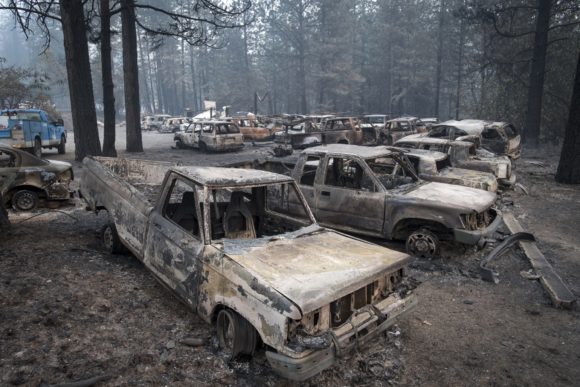PG&E Corp. told a judge it “strongly disagrees” with a Wall Street Journal storysuggesting that the utility knew its equipment near the ignition point of California’s deadliest wildfire badly needed upgrades and nonetheless deferred maintenance.
The company’s response, filed Wednesday, was ordered this month by a federal judge who demanded a “fresh, forthright statement owning up to” the accuracy of the article.
The utility is under criminal investigation in Butte County, California, where the Camp Fire, which raged in the northern part of the state for two weeks in November, destroyed the town of Paradise, killing 85 people. PG&E filed for bankruptcy after the fire. The state agency known as Cal Fire concluded the utility’s equipment caused the fire.
In the rebuttal to the Wall Street Journal article provided to the judge, PG&E acknowledged that it had proposed replacing 60 towers on the line that runs through Butte County where the fire started. But the company said that was for work required to meet federal standards and that the scope of the project didn’t target the particular transmission tower where the power line failed and the fire started. It also said that from 2014 to 2017, only a small portion of the fires caused by the utility were sparked by transmission lines.
“The Journal’s article on PG&E was deeply sourced and thoroughly reported,” Steve Severinghaus, a spokesman for the newspaper, said in an emailed statement. “Company officials were given ample opportunity to respond in advance of publication. Their lawyers have strained to no avail to challenge our article, which we stand behind fully. ”
U.S. District Judge William Alsup has said PG&E’s failure to cut and trim vegetation and branches was a cause of some fires in northern California in 2017 and 2018. He is overseeing the company’s probation after it was convicted in 2016 of safety violations stemming from a 2010 gas-line explosion in San Bruno, California, that killed eight people.
Alsup’s July 10 order also cited an ABC News report about recent political campaign contributions, and demanded that the company disclose the full amounts and recipients of the donations. He also demanded an explanation as to why $5 billion in dividend payments took precedence over managing vegetation that posed a fire threat.
PG&E said in 2017 and 2018 it made political contributions of $5.3 million, paid for by shareholders and not money from customers.
Responding to Alsup’s concerns about dividend payments, the utility said revenue from customers isn’t sufficient to support operations and infrastructure. PG&E needs to issue dividend payments to raise money from capital markets, it said.
“Dividends facilitate investment in infrastructure, because the steady payment of dividends is essential to raising new capital from investors,” PG&E said.
According to the Wall Street Journal article, a year before the Camp Fire PG&E conceded to a lawyer for California that it needed to undertake many projects to prevent failures of its power transmission system, and that the utility knew parts of it were outmoded.
Related to the Camp fire specifically, “the company knew that 49 of the steel towers that carry the electrical line that failed needed to be replaced entirely,” the Wall Street Journal reported. The utility only started detailed inspections of transmission lines after the fire, according to the article.
PG&E had delayed replacement of the towers on the line for a variety of reasons including “engineering, operational and permitting” issues, the utility said in its filing. The company said it needed to replace the towers to comply with federal clearance standards for its lines and the work wasn’t “to identify and repair or replace worn or broken parts”.
PG&E also denied that it only began close inspections of its transmission lines after the Camp Fire, saying it conducted ground inspections of overhead lines at least every five years and aerial patrols every year when a detailed inspection wasn’t done, according to the filing.
The case is U.S. v. Pacific Gas and Electric Co., 14-cr-00175, U.S. District Court, Northern District of California (San Francisco).
Was this article valuable?
Here are more articles you may enjoy.


 Zillow Deleting Climate Risk Scores Reveals Limits of Flood, Fire Data
Zillow Deleting Climate Risk Scores Reveals Limits of Flood, Fire Data  ‘Dream Is in Sight:’ Chamber, Reinsurers, Insurers Urge Florida to Stay the Course
‘Dream Is in Sight:’ Chamber, Reinsurers, Insurers Urge Florida to Stay the Course  Poorer Americans Dropped Federal Flood Insurance When Rates Rose
Poorer Americans Dropped Federal Flood Insurance When Rates Rose  LA Fires Push Insurers’ 2025 Disaster Losses to $107 Billion
LA Fires Push Insurers’ 2025 Disaster Losses to $107 Billion 